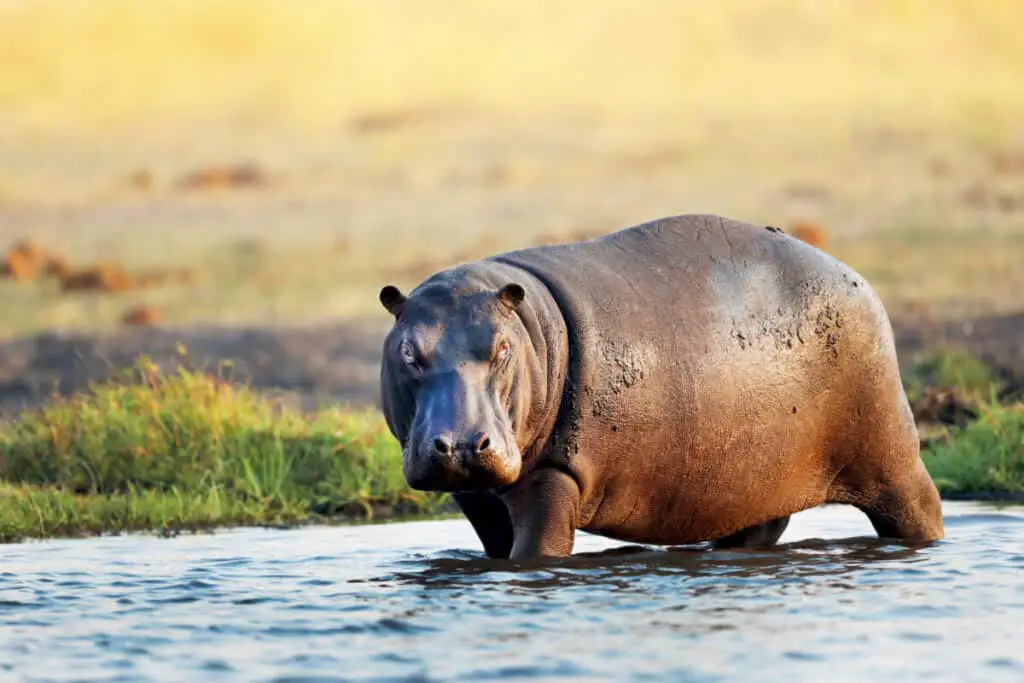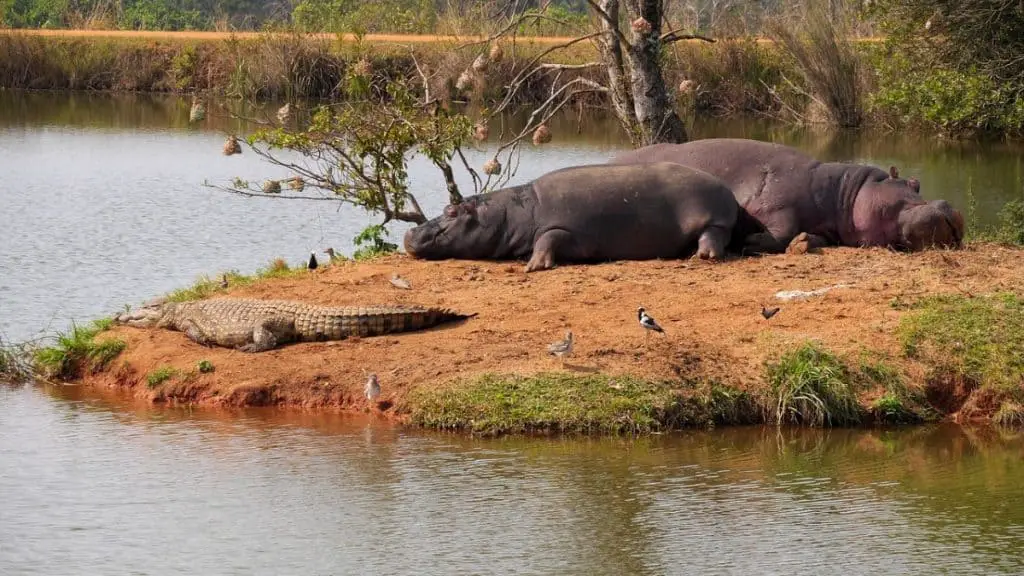Hippopotamus amphibius, commonly referred to as the hippopotamus or ‘hippo’ for short, is a large mammal native to Sub-Saharan Africa.
It is well known for its semi-aquatic lifestyle and ferocious reputation.
As an apex predator in African ecosystems, understanding their habitat preferences can provide important insight into species interactions and conservation efforts.
This article examines where hippos live in detail, taking into account recent research on their population dynamics and environmental needs.

Hippos In The Wild
Hippopotamus amphibius, commonly known as the hippo, is a large mammal found in sub-Saharan Africa. Hippos have adapted to their environment over thousands of years and occupy an important role within African ecosystems.
The adult hippo lives mainly in water during the day and feeds on grasses at night. It has a wide home range that includes areas of land, rivers and lakes. Breeding patterns vary among populations but typically involve solitary males or small groups of two or three individuals. Females give birth to one calf every two to four years after an eight month gestation period.
When it comes to food sources, hippos are primarily grazers, feeding on short grass species growing in marshy areas near bodies of water. They also consume aquatic plants such as papyrus when available, foraging for up to 16 hours per day depending on seasonality and availability of resources.
In extreme cases they may even resort to cannibalism if food becomes scarce.
The adaptability of the hippo is impressive; it can survive without access to drinking water for extended periods due its ability to produce moisture from metabolic processes as well as by eating succulent vegetation. This allows them thrive in environments with limited fresh water resources making them one of the most successful herbivores in Africa today.
| Species | Geographic Range |
|---|---|
| Common Hippopotamus | Sub-Saharan Africa (including countries like Kenya, Tanzania, Zambia, Botswana, and more) |
| Pygmy Hippopotamus | Restricted to parts of West Africa (including countries like Liberia, Ivory Coast, Sierra Leone) |
Hippos are primarily found in sub-Saharan Africa, inhabiting rivers, lakes, swamps, and other aquatic environments. They are most commonly found in regions with abundant water sources and suitable vegetation for grazing.
Geographic Range
Hippos are large, semi-aquatic mammals that live in sub-Saharan Africa and are native to the area. To survive, they require a warm climate with access to water for swimming and cooling off as well as ample vegetation for feeding. As such, their range is largely influenced by these factors.
When considering geographic range, it is important to note hippo migration patterns. Hippos move between different bodies of water throughout the year based on environmental conditions; during dry spells they will travel further in search of suitable habitat.
Additionally, since hippos feed mainly on grasses they need an abundance of vegetation in order to sustain themselves which also influences where they roam over time.
It is clear that the ideal environment for a hippo consists of plenty of fresh water sources combined with lush grazing areas—conditions found across much of sub-Saharan Africa today. However, due to human population growth and development there has been a decrease in available habitats which can lead to conflict situations and even endangerment for some populations if not managed properly.
Unveiling the Marvels of Hippopotamus: Nature’s Mighty River Guardians
Preferred Habitats
Hippos have a wide geographic range, ranging from the south of Sudan to the Cape Province in South Africa. They inhabit rivers, lakes and swamps across much of Sub-Saharan Africa.
While they can survive both on land and water, their preferred habitats are slow-moving rivers with deep waters for protection when threatened by predators or other hippos.
The mating rituals of hippos are fairly complex as males fight for dominance over females that become sexually mature at eight years old.
Males will establish hierarchies based on size and strength which leads them to create territories around groups of females that he deems his own harem.
This behavior is also seen during feeding habits where dominant males show aggression towards subordinate individuals who try to feed alongside them.
Hippos consume large amounts of vegetation daily including grasses, fruits, leaves and bark depending on what’s available near to their habitat.
As semi-aquatic mammals they spend most of the day submerged underwater browsing along river beds while using their snouts to dig up roots or pull plants off trees if need be.
Hippos tend to graze close together which leads them into occasional aggressive confrontations between themselves even though they remain largely non-aggressive animals despite being territorial creatures.
Hippo Behavior: Unveiling the Intriguing Habits
Climate And Temperature
Hippopotamuses, one of the most iconic animals in Africa, have long been an object of fascination for scientists. Despite their stature and popularity, these elusive creatures are surprisingly difficult to study due to their nocturnal habits and preference for aquatic habitats.
While it is clear that hippos live primarily in sub-Saharan Africa, there remain many unanswered questions about their climate and temperature requirements as well as breeding patterns and water sources.
The first clue about a hippo’s preferences lies in its anatomy: Hippos possess a thick layer of skin which helps them retain moisture even when submerged underwater. This adaptation indicates that they prefer warm climates with abundant water sources such as rivers or lakes where they can stay cool while grazing on grasses during the day. Furthermore, studies show that the species’ preferred body temperatures range from 32°C – 34°C (90°F – 93°F). In order to achieve this ideal temperature range, hippos must keep out of direct sunlight by either staying in the shade or submerging themselves entirely underwater during hot periods.
Although little is known about specific habitat preferences within different geographic regions, researchers believe that access to adequate food sources and clean bodies of water plays a major role in determining where certain populations settle. For example, some areas closer to human settlements may provide easier access to vegetation but could be lacking necessary resources such as freshwater pools or nearby breeding grounds essential for maintaining healthy populations.
As such, understanding how seasonal changes affect local ecosystems will be key moving forward if we want to uncover more details about where exactly hippos reside.
Unveiling the Marvels of Hippopotamus: Nature’s Mighty River Guardians

Social Interactions
Hippopotamuses are social creatures that live in groups of up to thirty individuals. They can be found in rivers and lakes across Sub-Saharan Africa, from the Senegal River eastward through Ethiopia and Somalia, southward to Tanzania and Zambia, with occasional sightings as far north as Egypt.
Social activities for hippos include:
- Feeding: Hippos graze on grasses throughout the night when temperatures are cooler. During this time, they move around more freely than during the day when it is hot outside.
- Solitary feeding: Hippos may also feed alone or away from their group if food sources become scarce.
- Dominating males will often try to establish dominance over females by pushing them away from a food source while grazing together.
- Breeding Behaviors & Mating Rituals: Male hippos reach sexual maturity between ages 7-10 years old and breed year round depending on geographic location. Females reach sexual maturity at around 5 years old and have an 11 month gestation period before giving birth to one calf after about 45 minutes of labor.
After breeding season has passed, male hippos will disperse back into their solitary lifestyle until the next breeding season comes around. Some female hippos remain part of larger family groups even after raising calves which allows them protection against large predators like lions and hyenas.
Hippopotamus populations have been in decline due to habitat destruction caused by human activity such as agricultural expansion and water pollution making it increasingly difficult for them to find enough resources needed for survival within their natural range. Conservation efforts need to focus on preserving existing habitats so future generations can continue observing these animals in their native environment.
Human Impact On Hippo Habitats
Hippos are found in the sub-Saharan region of Africa, mainly inhabiting rivers and lakes. These large mammals require a good supply of water to survive and human activity has become an increasingly significant factor in influencing their habitats.
Environmental degradation due to the expansion of agricultural land, illegal poaching, and habitat fragmentation resulting from construction activities have had negative impacts on hippo populations throughout much of its range. The destruction or alteration of wetland areas is particularly concerning as it reduces the amount of quality aquatic habitat available for these animals.
As wetlands provide important ecological services such as nutrient cycling and food production, further damage could have far reaching consequences not only for hippos but also other species that rely on them for survival. In addition, changes to the physical environment can lead to shifts in vegetation composition which often makes it difficult for hippos to find suitable places to feed.
In order to protect hippo populations from further decline, there needs to be increased efforts towards conservation initiatives aimed at preserving wetlands and improving existing ones. This should include promoting public awareness campaigns about environmental protection and encouraging sustainable development practices within communities living alongside these bodies of water. Such measures would help ensure that future generations continue to enjoy seeing this iconic African animal in its natural environment.
Conservation And Protection Efforts
Hippos are an iconic species of the African continent, being both admired and feared by humans. Their powerful bodies move through rivers like a tank in a war zone, their bellows echoing across valleys and plains alike. With this formidable presence comes a need for conservation and protection efforts to ensure these majestic creatures remain in our world for generations to come.
One major factor that contributes to the endangerment of hippos is loss of food sources due to human interference. As agricultural activities expand into formerly wild areas, there is less acreage available for grazing animals such as hippos. In addition, natural disasters have caused destruction throughout habitats, leading to large-scale displacement of native wildlife populations.
Therefore it is necessary to create protected environments where species can survive without disruption from human activity or climate change. Establishing conservation sites with adequate resources and space is essential when attempting to protect endangered species including Hippopotamus amphibius. Creating buffer zones outside the core area will limit access while also providing additional nutrition sources; research has shown that these secondary areas can be just as important for long-term viability of certain animal populations as the primary habitat itself.
Additionally, education programs aimed at informing locals about the importance of preserving biodiversity should be employed in order to encourage sustainable practices among those living near protected areas. By taking action now against threats facing hippos today we can guarantee they continue roaming free alongside us tomorrow.
Conclusion
Hippos are an iconic species found in many areas of Africa. Despite their large size, they have adapted to inhabit a variety of habitats ranging from swamps and rivers to grasslands and forests.
In order to survive, hippos must live in an environment that provides them with adequate access to water and food sources as well as suitable temperatures for their unique physiology.
To ensure their survival into the future, conservation efforts need to be taken to protect these remarkable animals from human-caused threats such as habitat loss, poaching, and climate change.
Much like a tree needs sunlight to thrive, so too does the hippo need clean water and suitable land in order to thrive. By preserving this essential resource we can help guarantee the continued existence of this magnificent creature on our planet for generations to come.

